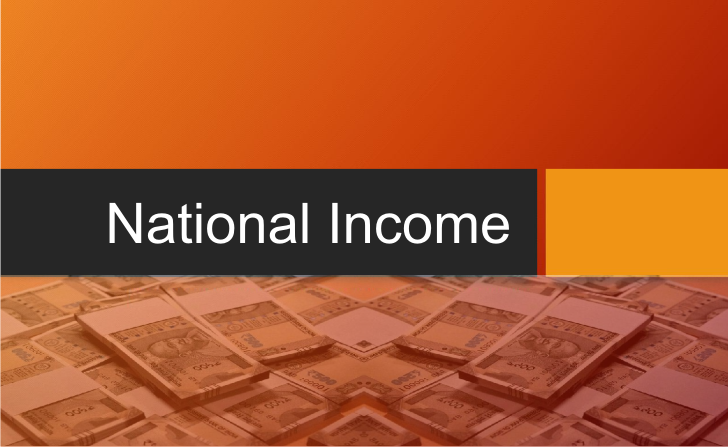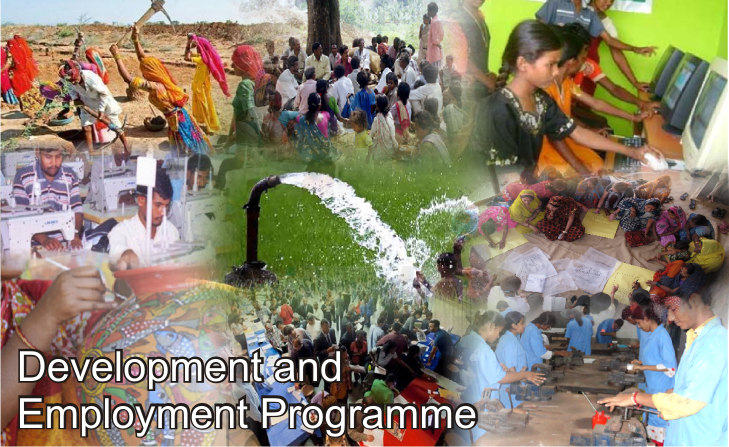- Agriculture sector provides livelihood to 65% to 70% of total population. This sector provides employment to 48·9% of country’s workforce and is the single largest private sector occupation.
- A major new mission has been launched during the 12th Plan is the ‘National Mission for Sustainable Agriculture’ (NMSA).
- Dryland Agriculture, Risk Management, Access to Information and use of Bio-technology are focus areas of NMSA.
- NMSA is one of the eight miss-ions under the National Action Plan on Climate Change. The other 7 Missions are :
(i) National Solar Mission.
(ii) National
|
2nd Advance Foodgrains Estimates During 2016-17 |
| The 2nd Advance Estimates of production of major crops for 2016-17 have been released by the Department of Agriculture, Cooperation and Farmers Welfare on 15th February, 2017.
As per 2nd Advance Estimates, the estimated production of major crops during 2016-17 is as under :
* Rice–108·86 million tonnes (record) * Wheat–96·64 million tonnes (record) * Coarse Cereals–44·34 million tonnes (record) * Maize–26·15 million tonnes (record) * Pulses–22·14 million tonnes (record) * Gram–9·12 million tonnes * Tur – 4·23 million tonnes (record) * Urad – 2·89 million tonnes (record)
* Soyabean–14·13 million tonnes * Groundnut–8·47 million tonnes * Castorseed–1·74 million tonnes
|
| Minimum Support Prices (Crop Year) of Major Crops (R/Quintal) | ||
| Commodity | 2015-16 | 2016-17 |
| Kharif Crops | ||
| Paddy (Common) | 1410 | 1470 |
| Paddy (Grade ‘A’) | 1450 | 1510 |
| Jowar (Hybrid) | 1570 | 1625 |
| Jowar ((Maldandi) | 1590 | 1650 |
| Bajra | 1275 | 1330 |
| Ragi | 1650 | 1725 |
| Maize | 1325 | 1365 |
| Tur (Arhar) | 4625^ | 5050* |
| Moong | 4850^ | 5225* |
| Urad | 4625^ | 5000* |
| Groundnut | 4030 | 4220$ |
| Sunflower Seed | 3800 | 3950$ |
| Soyabean (Yellow) | 2600 | 2775$ |
| Sesamum | 4700 | 5000# |
| Nigerseed | 3650 | 3825$ |
| Cotton | ||
| (Medium Staple) | 3800 | 3860 |
| Cotton | ||
| (Long Staple) | 4100 | 4160 |
| Rabi Crops | ||
| Wheat | 1525 | 1625 |
| Barley | 1225 | 1325 |
| Gram | 3425^^ | 4000** |
| Lentil (Masur) | 3325^^ | 3950## |
| Rapeseed/Mustard | 3350 | 3700* |
Source : Commission for Agricultural Costs and Prices (CACP).
Notes : Figures in brackets indicate percentage increase. ^ : Included Bonus R 200 Per quintal, * : Including Bonus R 425 per quintal, $ : Including Bonus R 100 per quintal, # : Including Bonus R 200 per quintal, ^^ : Additional bonus R 75 per quintal, ** : Including bonus of R 200 per quintal, ## : Including bonus of R 100 per quintal.
Mission for Enhanced Energy Efficiency,
(iii) National Mission for Sustainable Habitat,
(iv) National Water Mission,
(v) National Mission for Sustaining the Himalayan Eco-System,
(vi) National Mission for the Green India,
(vii) National Mission for Strategic knowledge for Climate Change.
- Agriculture Ministry in its fourth advance estimates has revised food grain production estimates to 252·68 for the 2014-15 crop year. For 2016-17 (2nd Advance Estimates) food grain production has been estimated at 271·98 million tonnes.
- The share of agriculture and allied sector in the gross domestic product has registered a steady decline from 36·4% in 1982-83 to 17·4 per cent in 2015-16 (on the basis of new series base year 2011-12). For 2016-17 (1st Advance Estimates) it has been estimated at 17·0%.
- As against the growth target of 4% for agriculture and allied sector in the 12th plan, the growth registered in the years 2012-13, 2013-14 and 2014-15 stood at 1·2%, 4·2 and (–) 0·2% respectively. For 2015-16, it is estimated at 1·2% and for 2016-17 (1st advance estimates) it is placed at 4·1%.
- Agriculture in our country provides livelihood to about 60% of the population.
- Agriculture sector provides employment to 58·2% of country’s work force and is the single largest private sector occupation.
- Green Revolution in the country was actually started in the year 1966-67.
- Due to Green Revolution, the share of wheat in the total production has increased. The share of rice remained constant while the shares of coarse cereals and pulses has reduced.
- India is 2nd largest producer of fruits and vegetables in the world.
- Coarse cereals include jawar, maize, bajra, ragi and small millets.
- The Cabinet Committee on Economic Affairs (CCEA) has approved the MSPs of Kharif crops for 2016-17 crop year (July-June). Paddy (common) MSP has been hiked by 60 to 1,470 per quintal for 2016-17 crop year. Paddy MSP of Grade ‘A’ variety has been also raised by 60 to 1,510 per quintal.
- The Cabinet Committee on Economic Affairs (CCEA) has approved the Minimum Support Prices (MSPs) for Rabi Crops of 2016-17 season to be marketed in 2017-18. All the MPS’s are revised higher in the range of 100 to 400 per quintal. The prices are decides as per the recommendations of the Com-mission for Agricultural Costs and Prices (CACP).
- For the marketing year 2017-18, the MSP of wheat has been fixed at 1625/Quintal. For Barley it is fixed at 1325/Quintal.
- Nine oilseeds which are produced in India are groundnuts, mustard, toria, soyabean, sunflower, sesamum (til), castorseed, nigerseed, linseed and safflower (kardi).
- Madhya Pradesh has the highest production of soyabean in India.
- India holds second position after Brazil in the world in the produc-tion of sugarcane and sugar.
- The Cabinet Committee on Eco-nomic Affairs (CCEA) has
approved to raise buffer food-grain stocks with the Food Cor-poration of India, to cater to the rising needs of Targeted Public Distribution System (TPDS) due to the implementation of the Food Security Act. - The ACP has recommended the government to keep the fair and remunerative price for sugarcane unchanged at 230/Quintal for 2016-17 (October-September).
- As per revised norms, the FCI will have to keep more grain rice and wheat in July and October, when the grain stocks held with it would usually be at higher levels.
- The revised buffer norm for April 1 is 21·04 million tonnes of wheat and rice as against the present 21·2 million tonnes. For July 1, it is 41·12 million tonnes as against 31·9 million tonnes. On October 1, the stock should be 30·77 million tonnes as against 21·2 million tonnes and on January 1, it should be 21·41 mil-lion tonnes as against 25 million tonnes. The buffer will include five million tonnes of strategic reserves of wheat and rice.
- India is world’s biggest producer and consumer of pulses. Initially India banned exports of the pulses in June 2006. It has been extending the ban since then.
- The growth target for agriculture in 12th plan (2012–17) remains at 4% p.a.
- West Bengal, Andhra Pradesh, Uttar Pradesh and Punjab were the top four producers cumulatively accounting for half of the country’s rice production.
- India produces 45% of the global production of Cashew. India is the largest producer, processor, consumer and exporter of Cashew in the world.
- India contributes about 13% to the world vegetable production and occupies first rank in the production of cauliflower, second in Onion and third in Cabbage in the world.
- India’s share in the world production of mango is about 54%.
- India occupies the first rank in banana production of 1·16 million tonnes.
- The present availability of human protein in an Indian diet is 10 gm per person per day as against a world average of 25 gm.
- Globally India is the second largest producer of silk and contributes about 18% to the total world raw silk production.
- The livestock sector contributes over 4 per cent to the total GDP and about a quarter of the GDF from agriculture and allied activities.
- The Cabinet Committee on Economic Affairs (CCEA) has approved a proposal to abolish the levy-sugar mechanism, under which private millers have to sell a specified quantity of the sweetener to the government at concessional rates.
The CCEA also dismantled the regulated release mechanism, which allows mills to sell only a specified quantity within a fixed time frame.
- National Seed Development Policy was adopted in 1988 which allowed import of seeds of coarse cereals, pulses, vegetables, flowers etc., but stopped the wheat and paddy seeds import. It is the first time when the government has also allowed the import of wheat and paddy seeds.
- Animal husbandry output constitutes about 30% of the country’s agriculture output.
- U.P. is the biggest wheat producing state in India. Punjab and Haryana hold second and third positions respectively.
- Rice is the main food crop in India. The biggest rice producing state is West Bengal. Punjab and Uttar Pradesh hold the second and third places respectively.
- The biggest coarse cereals producing area is Maharashtra. Karnataka and Rajasthan hold the second and third position respectively.
- The biggest pulses producing state is M. P., Maharashtra and Uttar Pradesh hold the second and third places respectively.
- Agriculture credit flow target for 2017-18 was fixed at 10,00,000 crore. During 2015-16 8,77,224 crore distributed as credit to agriculture sector, out of which 68·93% was distributed by commercial banks, 17·48% by cooperative credit banks, 13·60% by RRBs.
- For 2016-17 agriculture credit target was fixed at 9 lakh crore. As against target, the achieve-ment for 2016-17 (Upto Septem-ber 2016) was 84 per cent of the target.
- As per RBI’s guidelines domestic commercial banks/foreign banks with 20 and above branches have to distribute at least 18 per cent of their ANBC or credit Equivalent of off balance sheet expo-sure to agriculture either in the form of ‘direct finance’ or ‘indirect finance’.
- The distinction between direct and indirect agriculture is dispensed with from April 23, 2015 by the RBI.
- Union government has approved the Interest Subvention Scheme for farmers for the year 2016-17 on July 5, 2016. The government has earmarked a sum of 18,276 crore for this purpose. The scheme will help farmers to get short-term crop loan payable within one year upto 3 lakh at only 4% per annum.
- India is the largest producer and consumer of tea in the world and accounts for around 27% of world production and 13% of world trade.
- Under the present foreign trade policy, import of tea is permitted with an import duty of 100%.
- India contributes only 4% of world coffee production, but India ranks sixth in world coffee production.
- Among plantation crops, coffee has made significant contribution to the Indian economy during the last 50 years.
- India is the fourth largest producer of natural rubber (NR) with an 8·2 per cent share in world production in 2010. The small-holding sector accounted for 89 per cent of rubber planted area and 93 per cent of NR production.
- Karnataka which is the largest producer of coffee in the country accounts for 56·5% of total coffee production in India.
- Domestic demand for coffee in the country is about 70000 tonnes per annum. 70% of the total coffee production is exported from India.
- India is the largest producer and consumer of black tea in the world. Tea is grown in 16 states in India. Assam, West Bengal, Tamil Nadu and kerala account for about 96 per cent of the total production.
- The RKVY, a flagship scheme of the Government in the agriculture and allied sectors was launched in August 2007 to reorient current agricultural development strategies to meet the needs of farmers and rejuvenate the agricultural sector so as to achieve 4 per cent annual growth during the Eleventh Five Year Plan.
- Kerala is the main rubber producing state which produces 90% of rubber in the country and accounts for over 85% of the area under cultivation.
- The Price Stabilisation Fund Scheme (PSFS) for tea, coffee, rubber and tobacco growers was launched in April 2003 against the backdrop of decline in unit value realisation of these commodities, at times falling below their cost of production.
- India is the largest milk producing country in the world. During 2015-16, milk production was 146·31 million tonnes in the country, thus becoming an important secondary source of income for 70 million rural house-holds engaged in dairying.
| States Producing Highest Agriculture Crops | |
| Crop | State |
| Rice | West Bengal |
| Wheat | Uttar Pradesh |
| Maize | Andhra Pradesh |
| Coarse Cereals | Maharashtra |
| Pulses | Madhya Pradesh |
| Total Foodgrain | Uttar Pradesh |
| Grundnut | Gujarat |
| Total Oilseeds | Rajasthan |
| Sugarcane | Uttar Pradesh |
| Cotton | Gujarat |
| Jute/Mesta | West Bengal |
| Potato | Uttar Pradesh |
| Onion | Maharashtra |
Per capita availability of milk in 1950-51 was 124 gm/day which became 337 gm/day in 2015-16.
- The country is world’s fifth largest producer of eggs, sixth largest producer of fish and second in inland fisheries.
- Fisheries constitute about 1% of GDP of the country and 4·75% of agriculture GDP.
- About 14·4 million people are engaged in fishing, agriculture and other allied activities of which about 75 per cent are in inland fisheries and the remaining in marine fisheries.
- Fishing, acquaculture and alllied activities provide livelihood to over 14 million persons and also remained a major foreign exchange earner.
- Irrigation is one of the six com-ponents for development of rural infrastructure under Bharat Nirman.
- The Centrally Sponsored National Mission on Micro Irrigation (NMMI) was launched in June 2010 in addition to the earlier Micro Irrigation Scheme launched in January 2006. The mission is being implemented during the Eleventh Plan period for enhancing water-use efficiency by adopting drip and sprinkler irrigation systems in all States and Union Territories for both horticulture and agricultural crops.
- A scheme for the establishment and maintenance of a Seed Bank has been in operation since 1999-2000.
- Agricultural Insurance Co. of India Ltd. (AICIL) has intro-duced Rainfall Insurance Scheme known as ‘Varsha Bima’ during 2004 South-West monsoon period.
- India is the third highest tobacco producing country in the world. Annual production of tobacco in India is about 5·5 to 6·00 lakh tonnes.
- Pradhan Mantri Fasal Bima Yojana approved by the Union Cabinet on 13th January, 2016, there is a uniform premium of only 2% to be paid by the farmers for all Kharif Crops, 1·5% for all Rabi crops and 5% for commercial and horticulture crops.
- India ranked first in production of vegetable in the world. Besides India is the second largest producer of fruits in the world.
- At present India is the third largest fertilizer producing country in the world. India meets 94% of nitrogen fertilizer domestic demand and 82% of phosphate fertiliser domestic demand. For potash fertiliser India is totally dependent on imports.
- Nitrogenous fertilizers accounts about 60% share in total fertiliser consumption while share of pottasic fertilizers is about 12%.
- Per hectare fertilizer application is quite high in Punjab, Haryana, Andhra Pradesh and Tamil Nadu but quite low in Rajasthan, Odisha and Madhya Pradesh.
- National Bamboo Mission is a centrally sponsored scheme with 100% central assistance. The scheme commenced in 2006-07 and aims at holistic development of the bamboo sector in India.
- Horticulture crops occupy around 10% of gross cropped area of the country.
- India accounts for 26·9% of the world’s production of horticulture crops.
- There are 21,221 rural primary periodic agricultural markets, but of which 15% function under the ambit of regulation.
- The Integrated Scheme of oil- seeds, pulses, oil Palm and Maize (ISOPOM) is being implemented in 14 major states for oil seeds and pulses, 15 for maize and 10 for oil palm. the pulses component has been merged with the National Food Security Mission (NFSM) with effect from April 1, 2010.
- Noted Agri.-Scientist Dr. Swaminathan gave a new call for ‘Ever-green Revolution’ for doubling the present production level of foodgrains from 210 million tonnes to 420 million tonnes.
- Union government has planned to establish Rural Knowledge Centres in various states through NABARD. Initially these centres will be established in Andhra Pradesh, Gujarat, Karnataka, Maharashtra, Odisha, Pudu-cherry, Rajasthan, Tamil Nadu, Uttarakhand and West Bengal.
- Prime Minister Narendra Modi launched agro e trading platform e-NAM on April 13, 2016. The e-NAM trading mechanism pro-poses to integrate 585 regulated wholesale markets or Agriculture produce Market committee under one electronic platform.











